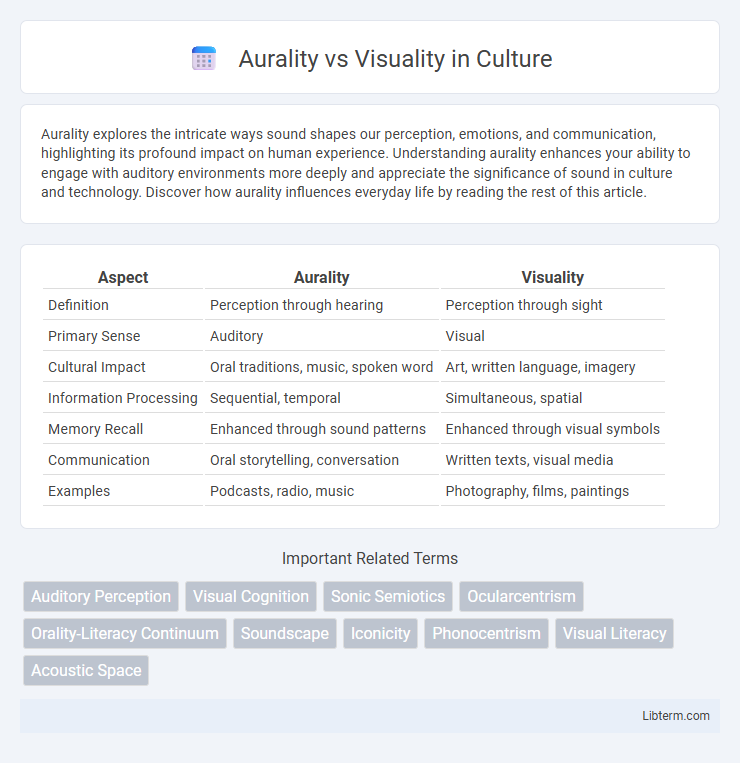Aurality explores the intricate ways sound shapes our perception, emotions, and communication, highlighting its profound impact on human experience. Understanding aurality enhances your ability to engage with auditory environments more deeply and appreciate the significance of sound in culture and technology. Discover how aurality influences everyday life by reading the rest of this article.
Table of Comparison
| Aspect | Aurality | Visuality |
|---|---|---|
| Definition | Perception through hearing | Perception through sight |
| Primary Sense | Auditory | Visual |
| Cultural Impact | Oral traditions, music, spoken word | Art, written language, imagery |
| Information Processing | Sequential, temporal | Simultaneous, spatial |
| Memory Recall | Enhanced through sound patterns | Enhanced through visual symbols |
| Communication | Oral storytelling, conversation | Written texts, visual media |
| Examples | Podcasts, radio, music | Photography, films, paintings |
Understanding Aurality and Visuality
Aurality involves the perception and interpretation of sound, emphasizing auditory processes and spatial awareness through hearing. Visuality centers on the reception and analysis of visual stimuli, prioritizing light, color, shape, and movement to construct meaning. Understanding aurality and visuality requires recognizing their distinct sensory pathways and cognitive frameworks that shape human experience and communication.
Historical Perspectives on Aurality and Visuality
Historical perspectives on aurality reveal its dominance in pre-literate societies, where oral traditions, storytelling, and communal listening shaped cultural transmission and social cohesion. Visuality gained prominence with the advent of writing systems, printed texts, and later, digital media, transforming knowledge dissemination through visual representation and symbolic literacy. The shift from aural to visual modalities marks a significant evolution in human communication, influencing cognition, power structures, and epistemological frameworks across civilizations.
Cognitive Differences: Hearing vs Seeing
Aurality engages the brain's auditory cortex, enhancing temporal processing and memory for sounds, while visuality activates the occipital lobe, optimizing spatial recognition and pattern detection. Hearing relies heavily on sequential information processing, facilitating real-time interpretation of language and environmental sounds, whereas seeing enables simultaneous analysis of complex scenes and symbolic representations. These cognitive differences influence how individuals encode, store, and retrieve information, highlighting the distinct neural pathways and mental strategies involved in auditory versus visual perception.
Cultural Impacts of Aural and Visual Communication
Aural communication shapes cultural identity by preserving oral traditions, storytelling, and communal memory, fostering a sense of belonging through shared auditory experiences. Visual communication influences culture through symbols, art, and media, enabling the dissemination of ideologies and values across diverse societies with lasting visual impressions. The interplay between aural and visual communication reflects and transforms cultural dynamics, affecting how knowledge, beliefs, and social norms are transmitted and sustained globally.
The Role of Technology in Shaping Sensory Experience
Technology profoundly influences sensory experience by enhancing both aurality and visuality through advanced devices like high-fidelity headphones and ultra-high-definition displays, which deepen sensory immersion. Innovations in virtual and augmented reality integrate auditory and visual stimuli to create multisensory environments that redefine perception and interaction. These technological developments shape cultural consumption by prioritizing sensory modalities that align with evolving digital communication and entertainment platforms.
Aurality vs Visuality in Modern Education
Aurality in modern education emphasizes the role of listening and auditory processing in learning, harnessing podcasts, audiobooks, and oral discussions to enhance comprehension and retention. Visuality complements this by integrating images, videos, and written texts to support visual learners and facilitate multimodal knowledge acquisition. Balancing aural and visual modalities optimizes educational outcomes by addressing diverse cognitive preferences and improving overall engagement.
Art and Expression: Soundscapes versus Visual Art
Aurality in art emphasizes immersive soundscapes that evoke emotions and memories through layered auditory experiences, often engaging the listener's imagination and bodily perception. Visuality centers on visual art forms, such as painting and photography, using color, composition, and imagery to convey meaning and provoke intellectual and emotional responses. Both modalities uniquely shape expression by stimulating different sensory pathways, with soundscapes fostering temporal engagement and visual art prioritizing spatial understanding.
The Influence of Media on Sensory Perception
Aurality emphasizes auditory experiences and the processing of sound, shaping how individuals interpret environments and information through hearing. Visuality centers on sight as the dominant mode of perception, influencing cognitive interpretations via images and visual stimuli. Media technologies amplify either aural or visual senses, significantly altering sensory perception by prioritizing soundscapes in radio and podcasts or visual content in television and digital platforms.
Blurring Boundaries: Multisensory Experiences
Aurality and visuality intersect in multisensory experiences by blurring the boundaries between hearing and seeing, enhancing perception through integrated sensory input. This fusion enables environments where sound shapes spatial awareness as much as visual cues, creating immersive atmospheres in art, virtual reality, and everyday life. The multisensory approach exploits neurological cross-modal interactions, intensifying emotional and cognitive engagement by synchronizing auditory and visual stimuli.
Future Trends in Aural and Visual Modalities
Future trends in aural and visual modalities emphasize immersive technologies such as spatial audio and augmented reality, enhancing human-computer interaction through multisensory experiences. Advances in AI-driven sound recognition and computer vision are enabling real-time context-aware applications, transforming fields like virtual reality, autonomous systems, and remote collaboration. Emerging research highlights the integration of aural and visual data streams to improve accessibility, user engagement, and information processing efficiency in diverse digital environments.
Aurality Infographic

 libterm.com
libterm.com